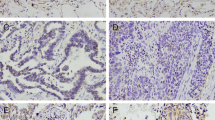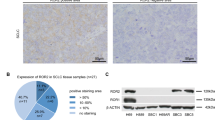Abstract
The present study aims to investigate the expression pattern of aryl hydrocarbon receptor nuclear translocator 2 (ARNT2) protein and its clinical significance in human non-small cell lung cancer (NSCLC). We investigated the expression levels of ARNT2 in 104 NSCLC surgical specimens by immunohistochemistry and then analyzed its clinical significance. Additionally, the role of ARNT2 on the biological properties of the NSCLC line HCC827 was experimentally tested in vitro and in vivo to confirm the clinical observations. We found that the expression level of ARNT2 was significantly higher in normal lung tissues compared with NSCLC tissues (P < 0.01). Overall survival (OS) of patients with a high intratumoral ARNT2 level was significantly longer than survival of those with a low ARNT2 level (P = 0.004). In addition, intratumoral ARNT2 expression was an independent prognostic factors for OS (hazard ratio [HR] = 0.529; P = 0.001). 3-(4,5-Dimethylthiazol-2-yl)-2,5-diphenyltetrazolium bromide (MTT) assay showed that the ARNT2 overexpression inhibited cell viability, while ARNT2 knockdown promoted cell growth in NSCLC cell lines HCC827 and A549. Annexin V/PI assay showed that ARNT2 overexpression increased cell apoptosis, while ARNT2 knockdown decreased cell apoptosis in HCC827 and A549 cells. Moreover, in vivo study showed that attenuated ARNT2 expression in HCC827 cells greatly promoted tumor growth, while overexpressed ARNT2 remarkably inhibited tumor growth in a HCC827 xenograft model. Taken together, our data demonstrate that ARNT2 might serve as a tumor suppressor in NSCLC progression.





Similar content being viewed by others
References
Jemal A, Bray F, Center MM, Ferlay J, Ward E, Forman D. Global cancer statistics. CA Cancer J Clin. 2011;61(2):69–90. doi:10.3322/caac.20107.
Peters S, Adjei AA, Gridelli C, Reck M, Kerr K, Felip E. Metastatic non-small-cell lung cancer (NSCLC): ESMO Clinical Practice Guidelines for diagnosis, treatment and follow-up. Ann Oncol. 2012;vii Suppl 7:56–64. doi:10.1093/annonc/mds226.
Li H, Zhang Y, Bai X, Peng Y, He P. TRIM31 is downregulated in non-small cell lung cancer and serves as a potential tumor suppressor. Tumour Biol. 2014;35(6):5747–52. doi:10.1007/s13277-014-1763-x.
Bersten DC, Sullivan AE, Peet DJ, Whitelaw ML. bHLH-PAS proteins in cancer. Nat Rev Cancer. 2013;13(12):827–41. doi:10.1038/nrc3621.
Hirose K, Morita M, Ema M, Mimura J, Hamada H, Fujii H, et al. cDNA cloning and tissue-specific expression of a novel basic helix-loop-helix/PAS factor (Arnt2) with close sequence similarity to the aryl hydrocarbon receptor nuclear translocator (Arnt). Mol Cell Biol. 1996;16(4):1706–13.
Reyes H, Reisz-Porszasz S, Hankinson O. Identification of the Ah receptor nuclear translocator protein (Arnt) as a component of the DNA binding form of the Ah receptor. Science. 1992;256(5060):1193–5.
Shi S, Yoon DY, Hodge-Bell KC, Bebenek IG, Whitekus MJ, Zhang R, et al. The aryl hydrocarbon receptor nuclear translocator (Arnt) is required for tumor initiation by benzo[a]pyrene. Carcinogenesis. 2009;30(11):1957–61. doi:10.1093/carcin/bgp201.
Onita T, Ji PG, Xuan JW, Sakai H, Kanetake H, Maxwell PH, et al. Hypoxia-induced, perinecrotic expression of endothelial Per-ARNT-Sim domain protein-1/hypoxia-inducible factor-2alpha correlates with tumor progression, vascularization, and focal macrophage infiltration in bladder cancer. Clin Cancer Res. 2002;8(2):471–80.
Liang Y, Li WW, Yang BW, Tao ZH, Sun HC, Wang L, et al. Aryl hydrocarbon receptor nuclear translocator is associated with tumor growth and progression of hepatocellular carcinoma. Int J Cancer. 2012;130(8):1745–54. doi:10.1002/ijc.26166.
Aitola MH, Pelto-Huikko MT. Expression of Arnt and Arnt2 mRNA in developing murine tissues. J Histochem Cytochem. 2003;51(1):41–54.
Hankinson O. Why does ARNT2 behave differently from ARNT? Toxicol Sci. 2008;103(1):1–3. doi:10.1093/toxsci/kfn032.
Martinez V, Kennedy S, Doolan P, Gammell P, Joyce H, Kenny E, et al. Drug metabolism-related genes as potential biomarkers: analysis of expression in normal and tumour breast tissue. Breast Cancer Res Treat. 2008;110(3):521–30. doi:10.1007/s10549-007-9739-9.
Qin XY, Wei F, Yoshinaga J, Yonemoto J, Tanokura M, Sone H. siRNA-mediated knockdown of aryl hydrocarbon receptor nuclear translocator 2 affects hypoxia-inducible factor-1 regulatory signaling and metabolism in human breast cancer cells. FEBS Lett. 2011;585(20):3310–5. doi:10.1016/j.febslet.2011.09.017.
Sribudiani Y, Metzger M, Osinga J, Rey A, Burns AJ, Thapar N, et al. Variants in RET associated with Hirschsprung’s disease affect binding of transcription factors and gene expression. Gastroenterology. 2011;140(2):572–82.e2. doi:10.1053/j.gastro.2010.10.044.
Sekine H, Mimura J, Yamamoto M, Fujii-Kuriyama Y. Unique and overlapping transcriptional roles of arylhydrocarbon receptor nuclear translocator (Arnt) and Arnt2 in xenobiotic and hypoxic responses. J Biol Chem. 2006;281(49):37507–16. doi:10.1074/jbc.M606910200.
Dougherty EJ, Pollenz RS. Analysis of Ah receptor-ARNT and Ah receptor-ARNT2 complexes in vitro and in cell culture. Toxicol Sci. 2008;103(1):191–206. doi:10.1093/toxsci/kfm300.
Conflicts of interest
None
Author information
Authors and Affiliations
Corresponding author
Rights and permissions
About this article
Cite this article
Yang, B., Yang, E., Liao, H. et al. ARNT2 is downregulated and serves as a potential tumor suppressor gene in non-small cell lung cancer. Tumor Biol. 36, 2111–2119 (2015). https://doi.org/10.1007/s13277-014-2820-1
Received:
Accepted:
Published:
Issue Date:
DOI: https://doi.org/10.1007/s13277-014-2820-1




